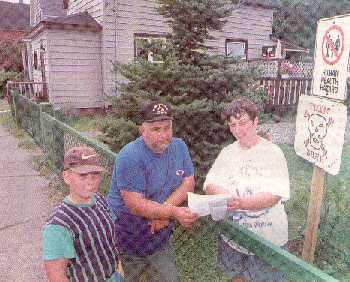Frederick
Street no health threat
Residents told no need to fear any long-term health effects
BY STEVE MACINNIS
Cape Breton Post
Despite their
proximity to what many consider to be North America's worst toxic industrial
waste dump, residents of Sydney's Frederick Street were told Wednesday
there is no reason to fear any long-term health effects.
The results
of health risk assessment study - by CANTOX Environmental Inc. - concluded
there has been chemical contamination in the neighborhood but no reason
to suspect any long-term adverse human health effects.
"We used widely
accepted scientific procedures for conducting the health risk assessment
of Frederick Street," said Christine Moore, eastern vice president of CANTOX.
She said resident
complaints of frequent ear and kidney infections result from bacterial
or viral infections and are not typically associated with chemical exposure.
 A
group of the streeet's residents were summoned to a meeting last night
at a community hall in Whitney Pier with Moore and Dr. Jeff Scott, the
province's chief medical officer.
A
group of the streeet's residents were summoned to a meeting last night
at a community hall in Whitney Pier with Moore and Dr. Jeff Scott, the
province's chief medical officer.
The majority
of the residents stormed out of the session shortly after it began and
slammed the report's findings.
"We kind of
knew what to expect. This doesn't end here. We've been in contact
with our own independent toxicologist and are speaking to lawyers," said
resident Ron McDonald.
McDonald said
he and the other half-dozen residents who left the meeting are convinced
the results of the CANTOX study were ordered by the provincial and federal
health departments who paid for the assessment.
Moore said
a final bill hasn't been prepared but placed the final tally in a range
of between $20,000 and $50,000.
It was last
April when residents first noticed an orange goo oozing from a bank of
a brook running through backyards on the street. Soil tests concluded
the goo was arsenic and identified levels exceeding national guidelines.
Levels of lead and other metals were also found to be elevated.
The residents
demanded they be relocated and also agreed to hair and blood samples to
discover whether they had become contaminated.
Those results
were released Tuesday and concluded the levels of arsenic and lead were
no great than "found in normal healthy Canadians."
Frederick
Street is located about 300 meters from the which
is now fenced off with signs posted, warning of a human health hazard.
 The area is the target of Canada's most ambitious remediation project which
will hopefully rid Sydney of its toxic legacy from its steel-making history.
The area is the target of Canada's most ambitious remediation project which
will hopefully rid Sydney of its toxic legacy from its steel-making history.
Nearly a century
after steel-making began, there lies a scarred and toxic landscape around
the plant, including the tar ponds which contain over 700,000 tonnes of
sludge laced with polychlorinated biphenyls (PCB) and poly aromatic hydrocarbons
(PAH).
A remediation
plan has been in the development stage since 1996 when a community based
group - Joint Action Group (JAG) - was formed to begin mapping out a strategy.
McDonald said
residents will continue to stay out of their backyards and are not convinced
there is no reason for fear long term health effects.
The CANTOX
study offered several recommendations:
-
a permanent solution to restrict
access to the seep area
-
continued monitoring of the brook
to detect change in chemical composition
-
restrict children from playing in
a nearby ash pile
-
ongoing monitoring of off-site migration
of chemicals fromt he watershed area
-
encourage residents living near the
site to become more involved in the JAG process
 Next
article
Next
article

Please
Sign Our Guestbook
View
Guestbook


CONTACT
Muggah Creek

 Read
all about the plight of the residents of Frederick Street, Whitney Pier,
Sydney, Nova Scotia
Contact
Juanita McKenzie, spokesperson for Frederick Street
Read
all about the plight of the residents of Frederick Street, Whitney Pier,
Sydney, Nova Scotia
Contact
Juanita McKenzie, spokesperson for Frederick Street
 A
group of the streeet's residents were summoned to a meeting last night
at a community hall in Whitney Pier with Moore and Dr. Jeff Scott, the
province's chief medical officer.
A
group of the streeet's residents were summoned to a meeting last night
at a community hall in Whitney Pier with Moore and Dr. Jeff Scott, the
province's chief medical officer.
 The area is the target of Canada's most ambitious remediation project which
will hopefully rid Sydney of its toxic legacy from its steel-making history.
The area is the target of Canada's most ambitious remediation project which
will hopefully rid Sydney of its toxic legacy from its steel-making history.
